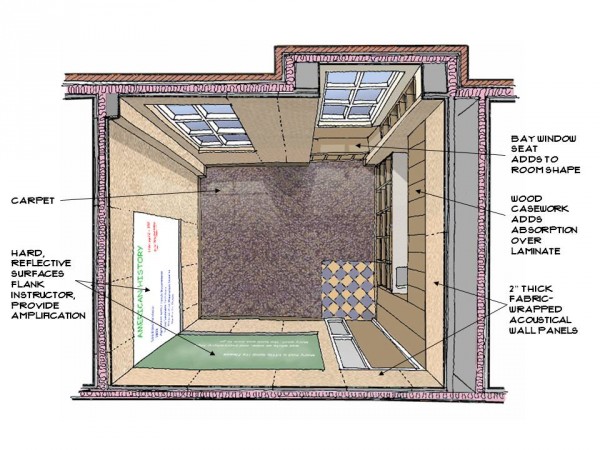This is part two of a five-part series. Read part one here and part three here.
Human beings have multiple senses, controlled by one magnificent brain. Readily apparent to even a child, these simple truths turn out to be pretty important for designing buildings.
Multiple Senses
In addition to the five we normally think of – vision, hearing, smell, taste, and touch – there are other senses humans can’t easily live without. Without the vestibular structures in both inner ears, we wouldn’t be able to sense acceleration… including that constant acceleration called gravity. Though our eyes might still tell our brains which way is up, we wouldn’t be able to keep our balance, much less walk or run. And without the kinesthetic sense of proprioception, we wouldn’t be able to touch our noses with our eyes closed, much less complete a no-look pass. We can debate other “senses” – like hunger, pain, or temperature – but the point is clear: humans are sensory beings.
if you’re designing buildings where people teach and learn, it’s really important to understand the senses, and how they interface with the brain
The reason it’s so important to keep these things in mind when designing buildings is that human beings can only experience and navigate our world (both the natural and man-made) with the constant help of our senses. Each of them evolved over eons to help us find food, vie for mates, and avoid predators. While we still do some of those things, humans rely just as heavily on our senses for things we didn’t always do – like play badminton, attend calculus lectures, and use touch screens. Vision and hearing in particular are really important for communication, and by extension, for any kind of learning. Until we figure out some kind of telepathy, the only way to get knowledge into or out of any brain is through the senses – especially the eyes and ears. So if you’re designing buildings where people teach and learn, it’s really important to understand the senses, and how they interface with the brain.
One Magnificent Brain
Even when deprived of sensory input, the human brain has shown itself to be remarkably adaptive. Helen Keller’s development, education, and signature wit stand as an extreme example of the human potential to overcome seemingly insurmountable sensory barriers. But we are only beginning to learn how amazingly complex the human brain is. The past couple of decades have seen a groundswell of important work in assessment and early intervention of developmental sensory and neurological issues. We now understand that many children with clear vision and full hearing have difficulty learning or paying full attention because of sensory processing issues in the brain.
When designing for people with limited or no visual or auditory ability, or who have sensory processing difficulties, it has been critically important for Mackey Mitchell’s design team to understand the barriers that buildings so often present for access, movement, communication, and learning – from blind corners in winding corridors to classrooms with noisy fan coil units. By focusing on all the sensory barriers that can occur in buildings, we uncover valuable new design solutions and strategies. A few examples:
With hearing, we regard the audible lesson being taught – whether from the voice of a teacher, a peer, or some recorded audio – as the signal, and everything else as background noise that can interrupt learning by blocking or masking the signal. We measure and model the signal-to-noise ratio mathematically when designing new classrooms. We do consider sound amplification technologies to elevate signal, but only after carefully managing and reducing all potential sources of background noise. We identify every source of possible classroom noise, sort them into four categories, and prioritize them by sound pressure level and frequency. We then focus every design decision around the classroom (wall construction, window size and placement, sealants, ducts, diffusers, finishes – the list goes on) toward reducing background noise in each of the four categories.
The same approach applies to vision, where signal equates to the teaching wall, projection screen, or the teacher’s face, and “visual noise” equates to unwanted glare from lighting, windows placed too close to a teaching surface, or movement in the peripheral field. The goal is the same – to elevate visual signal, reduce visual noise, and balance overall sensory comfort. For example, consider the contrast balance of a teaching wall. The visual signal itself biases high contrast – most preferably white chalk on a dark surface. But if the visual contrast from that dark surface to surrounding (bright white) walls and ceiling is too stark, the whole composition becomes jarring, and can compete with attention and focus. A more balanced solution examines the wider picture, providing a more uniform, low-contrast treatment of the whole wall, allowing the words and images of the visual lesson to provide the primary contrast. The same strategy recommends against open storage on or near a teaching wall – especially if it provides visual access to games or other activities students may find more interesting than the lesson.
With other senses, we seek to create stimulating environments (sensory deprivation is NOT good for human attention) that are not over-stimulating or distracting. If mechanical systems are not properly balanced, classrooms can be exposed to kitchen or cafeteria odors in the hour before lunch. When that happens, you probably lose more than students’ ability to focus. You lose the teacher, as well.
the design strategies Mackey Mitchell has developed in schools for the deaf and blind ultimately benefit ALL learners
When you consider the thousands of design decisions that go into the creation of any building, you begin to understand just how many strategies we have developed to improve the sensory commerce of teaching and learning. Because almost no one has perfect vision and hearing, the design strategies Mackey Mitchell has developed in schools for the deaf and blind ultimately benefit ALL learners.
Finally, because human sensory abilities tend to degrade with age, the future will probably find each of us more deaf and blind than we are now. Sensory-focused design will likely benefit all humans, and our magnificent brains.

 By: Marcus Adrian
By: Marcus Adrian 